Review: 2025 Audi SQ8 Combines Style With Substance
Driving along in the 2025 Audi SQ8, I feel conspicuous thanks to the bright metallic paint, blacked out trim, and the sinister coupe-like profile. In traffic, the SQ8 hasn’t impressed me yet, at least not enough to justify its $127,490 sticker price. The cabin is muted in black and I have yet to tap into the power or stress the handling enough to make a judgment. Is this thing only about style? Is there a good reason to want one?
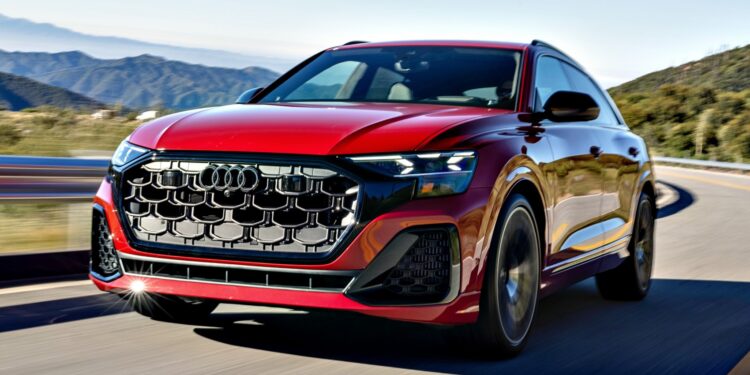
But then I find a country road that’s not only twisty but also rough. It’s a true test of the suspension and a chance to unleash the power away from traffic. I switch to Dynamic mode and have at it. Dynamic mode immediately wakes up the 4.0 liters of German V8 under the hood, raising the revs by holding gears longer, hastening the throttle response, and opening a butterfly valve in the mufflers to bypass the baffles and let the engine sing its deep and soulful tune at a volume above library quiet.
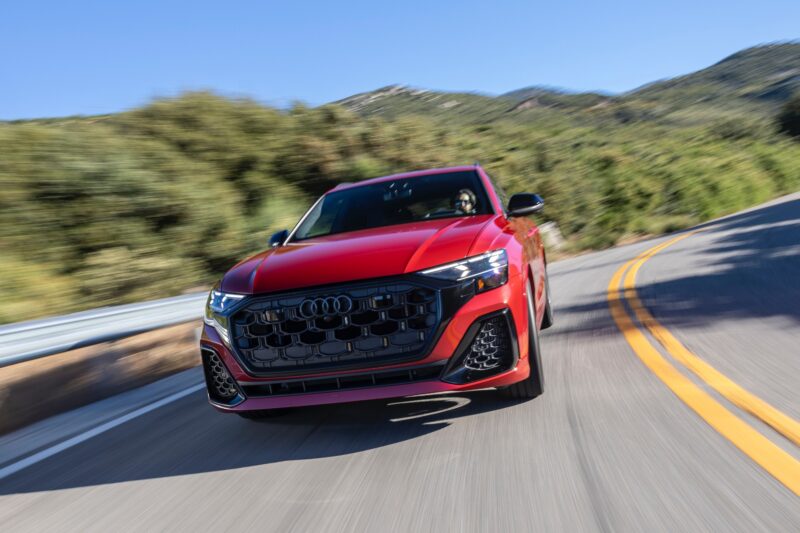
The twin-turbo V8 spins up 500 horsepower and 568 pound-feet of torque smoothly and confidently. The power arrives early, delivering a jolt from a stop when I step into it as all four wheels hook up thanks to the standard quattro all-wheel-drive system. The 0-60 mph sprint takes just 4.1 seconds, and the SQ8 builds speed easily. With so much power on tap, it’s hard to believe the RS Q8 sits above this model and turns up the wick to 617 horsepower.
The smooth-shifting eight-speed automatic transmission proves responsive as I link corner to corner. It downshifts to tap into the power coming out of the turns without overdoing it with extremely high revs and hard, disruptive shifts. The sport differential that’s included along with active anti-roll bars in this tester’s optional S sport package also apportions the power side to side at the rear for best traction on corner exit.
Opting for Auto or Comfort modes calms the powertrain, muting the sound, relaxing the throttle, and grabbing the next gear earlier. In these modes, the engine only makes itself known when my right foot gets too frisky. The downside of twin-turbo V8 is fuel economy. It’s EPA rated at 15 mpg city, 21 highway, and 17 combined. I’m only averaging 16.4 mpg per the trip computer.
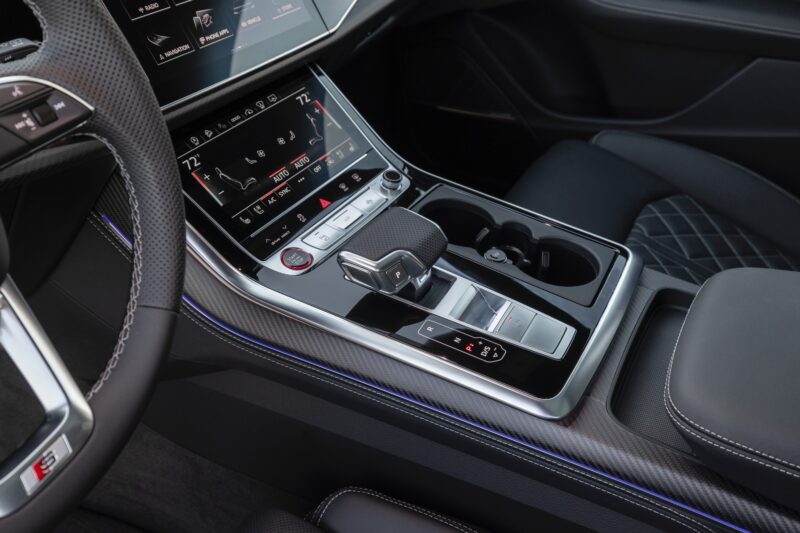
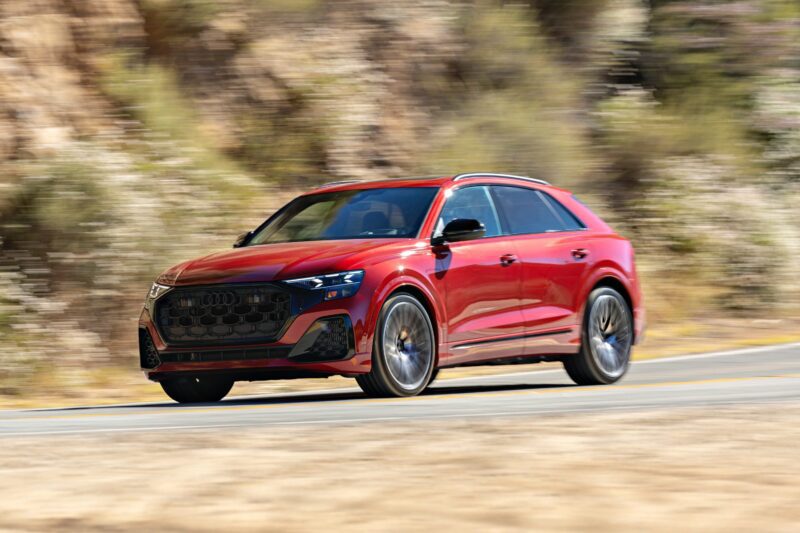
Dynamic mode also stiffens the chassis. The SQ8 has five-link independent suspensions front and rear, adaptive dampers, a four-corner air suspension, and rear axle-steering. While that’s all pretty advanced stuff, It’s the effect of the active anti-roll bars I feel most. When I toss 5,269 pounds of luxury SUV into a 180-degree lefthander, the anti-roll bars doggedly fight lean to keep the attitude flat, despite 8.2 inches of standard ground clearance and 6.6 inches in Dynamic mode. It feels like it’s defying physics. Not only that, but it rotates well, with just a touch of understeer that’s remedied easily by lifting off the throttle. The rear-axle steering likely doesn’t come into play here. It can turn the rear wheels up to five degrees opposite of the fronts, but that’s at parking lot speeds.
The hefty steering feels stable and the SQ8 reacts directly to my inputs. I’m getting pretty good feedback through the steering wheel, too. I can feel the bumps and ruts of the patchwork pavement without disrupting the ride quality. This is some deft suspension tuning as only the deeper potholes send a shock into the cabin, despite low-profile 285/35R23 Continental SportContact 6 summer performance tires. That’s a lot of unsprung weight to harness, but the SQ8 does it well. Braking is strong, too. Audi outfits the SQ8 with 15.8-inch front rotors with six-piston calipers and 13.8-inch rear rotors with single-piston calipers. The pedal remains firm throughout my shenanigans, but this isn’t a long and winding road and I’d be leery of them holding up on a track.
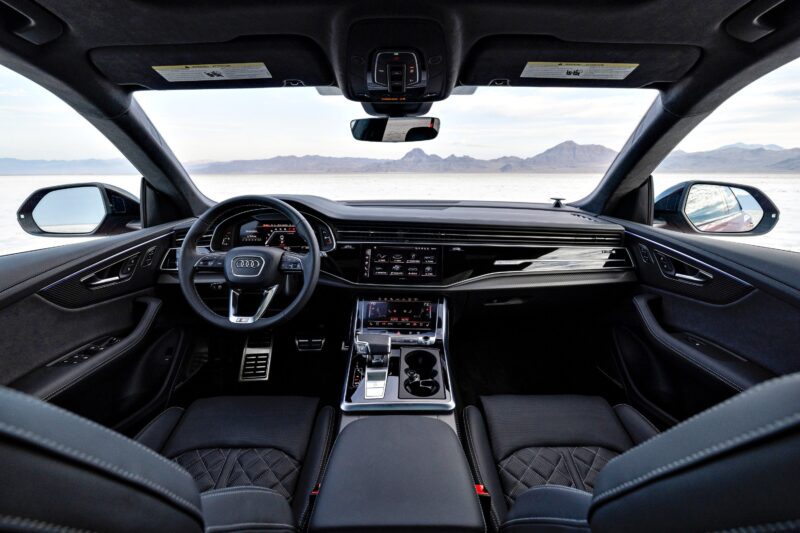
A closer look at the cockpit reveals well-chosen, high-quality materials and technology that while aging still looks cutting edge. The SQ8 comes with the screen layout introduced in 2019 with the redesign. It includes a 12.3-inch digital instrument cluster and stacked touchscreens on the dash and center stack. The top screen measures 10.1 inches and the bottom screen stretches 8.6 inches. Both provide haptic feedback to confirm touch inputs.
The bottom screen is for climate control functions, and the top screen and handles the typical infotainment controls: phone, navigation, and audio. It allows access to apps through the Audi Connect Plus subscription and can be controlled with voice commands. However, those commands can’t control vehicle functions like climate controls or lighting, which means the system is slightly behind the times. The system in the new Audi A5, for instance, incorporates ChatGPT into the navigation system, has even bigger screens, and offers a passenger screen.
While a color other than black (red is available) would create a more visually interesting interior atmosphere, the SQ8’s cabin materials are top notch. It comes standard with diamond-stitched Valcona leather upholstery, carbon-fiber trim, and aluminum and piano black surfaces. The $3,700 Luxury package included on my tester extends the leather to the dash, upper doors, center console, and armrests, and ands a synthetic suede headliner. Spending another $4,900 brings a bangin’ 19-speaker, 1,820-watt Bang & Olufsen Advanced 3D audio system, though the standard system is also from Bang & Olufsen and has 17 speakers base and 730 watts.
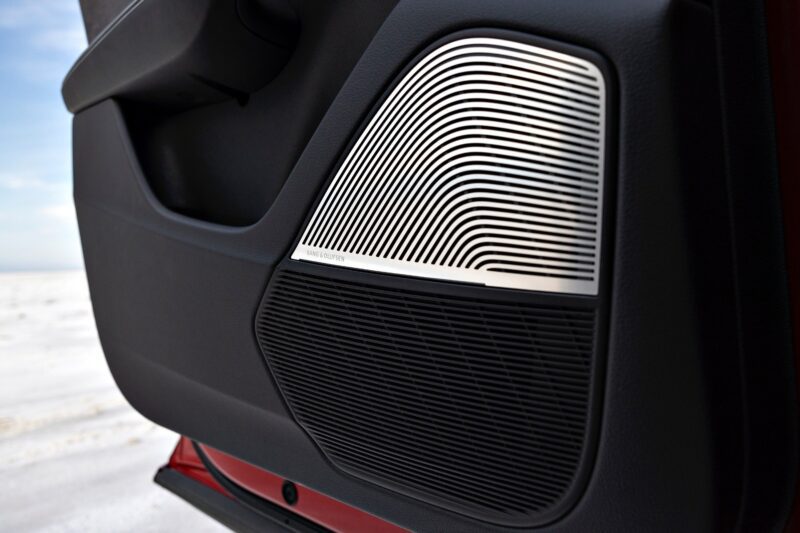
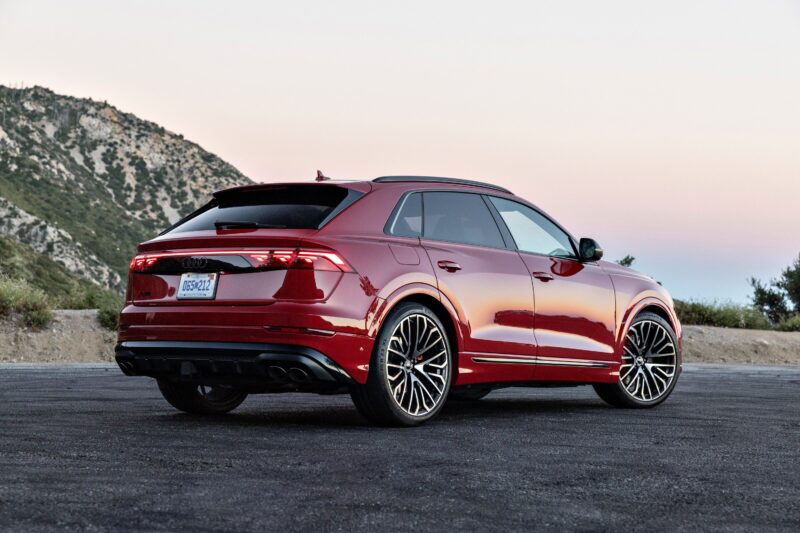
The Q8 family shares its platform and 118-inch wheel base with the Audi Q7. The Q7 cuts a more traditional SUV profile, though, and offers three rows of seats as well as more cargo space. The SQ8’s coupe-like rear roofline cuts into cargo space and precludes the third row. Still, the SQ8 has good second-row room for up to three adults, though two will be far more comfortable, and cargo space is decent at 33.7 cubic feet behind the rear seats and 60.8 cubic feet with rear seats folded down.
The 2025 Audi SQ8 starts at $98,895, including a $1,295 destination fee. That money gets you some of the equipment that makes this such an appealing luxury SUV, including the V8 goodness, the adaptive dampers, the air suspension, sporty suspension tuning, and the rear-axle steering. Inside it includes the screens, leather upholstery, four-zone automatic climate control, heated front sport seats, and wireless smartphone charging. Spending an extra $7,300 for the Prestige package, which is essentially a trim level, adds such niceties as dual-pane acoustic glass side windows, front seat ventilation and massage, Matrix LED headlights, a head-up display, heated rear seats, soft-close doors, and remote parking.
A full suite of active safety features is standard on all SQ8s. It consists of automatic emergency braking, adaptive cruise control, lane-departure warning, blind-spot monitors, rear cross-traffic alerts, traffic sign recognition, front and rear parking sensors, automatic high beams, and a surround-view camera system. Many of my test vehicle’s options are what make it so good. The $6,000 S sport package improves the dynamics, as does the $2,500 for the 23-inch wheels and summer performance tires. The Prestige package also adds features most buyers will find indispensable.
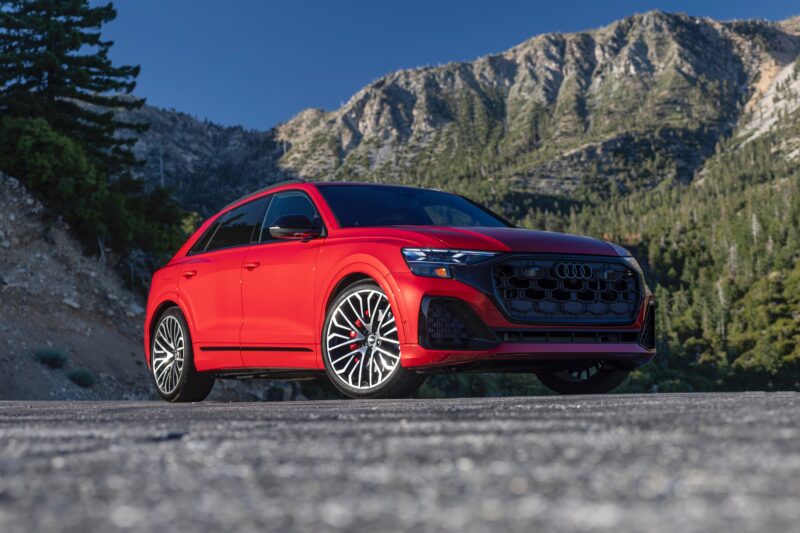
The 2025 Audi SQ8 may be aging, but it still has swagger to back up its style. It’s powerful, agile, and luxurious—especially if you pick the right set of options. It sacrifices some utility for its dashing good looks, but that’s part of the swagger, too. You don’t buy a luxury vehicle because you need one. You do it because you want to, and the Audi SQ8 makes me want one.
2026 Rivian Gen 2 R1S & R1T Quad-Motor Review: Sleeper Supercars in SUV and Pickup Truck Form
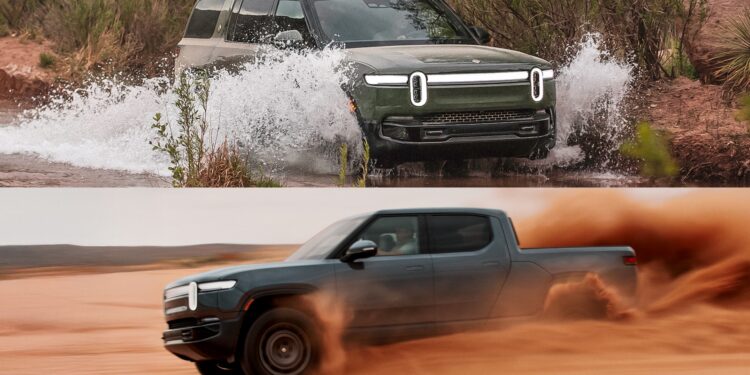
Instantaneously available electric power allows Rivian’s new Gen 2 Quad-Motor pickup truck and SUV to rip off 0-60 times just as fast, if not faster, than many seven-figure supercars. Those four motors, one powering each wheel, combine for total ratings of 1,025 horsepower and even more importantly, an absurd 1,198 pound-feet of torque – good enough for a claimed 0-60 mph time of just 2.5 seconds for the R1T and 2.6 seconds for the R1S. Plus, each Gen 2 Quad can now manage up to 400 miles of all-electric range in an updated Conserve mode that prioritizes efficiency rather than all-out performance.
Rivian achieved these mind-boggling stats by significantly working over the Gen 2, and then taking advantage of every last improvement for the flagship Quad-Motor variants. Neither looks particularly different from the outside, but beneath the skin lurks new motors, a new front inverter, and reduced electrical complexity that cuts out 10 fewer ECUs, while the remaining seven run far quicker processing speeds than on the Gen 1.
In addition to the on-road performance, Gen 2 also enhances the Quad’s off-road capability, for the adventurous lifestyle that makes up much of the Rivian appeal. Two new nifty features, RAD Tuner and Kick Turn, allow for quite possibly the most discretely complex set of adjustable performance parameters on any car ever, plus the ability to crank through tight turns or drifts on the fly. To show off the revived Quad’s insane power, off-roading prowess, and improved tech integration, Rivian recently invited me to join select media for a long drive day, on and off-road, around Lake Tahoe in Northern California.
A Day of Adventure in the New Rivians
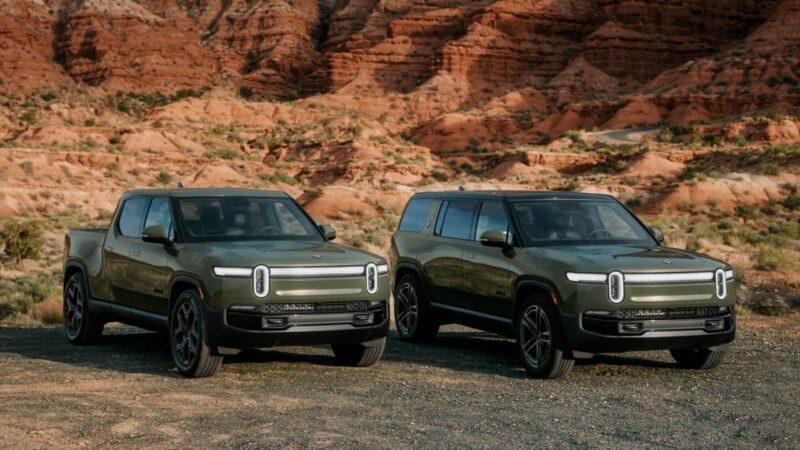
For Gen 2, Rivian purposefully limited the R1S and R1T’s stylistic changes. The SUV and pickup profile therefore look quite familiar, though the Launch Edition spec brings back the popular Launch Green paint job, while every Quad receives blue brake calipers and subtle blue badging surrounds. Rivian’s hilarious cartoon character nicknamed “Gear Guard” dots the body panels, too, which might be the easiest way to tell a Quad apart from lower-spec models.
Otherwise, the clever storage solutions, big central touchscreen, three rows for the R1S, and a surprisingly usable pickup bed for the R1T carry over. But my main goal for the Tahoe program? Figuring out whether the new Quads improve on some of Gen 1’s main flaws: namely, the suspension and steering calibrations. Early in the morning, running along the lake’s west coast, I immediately started fiddling with RAD Tuner, hoping to figure out a way to program out some of my least favorite driving dynamics.
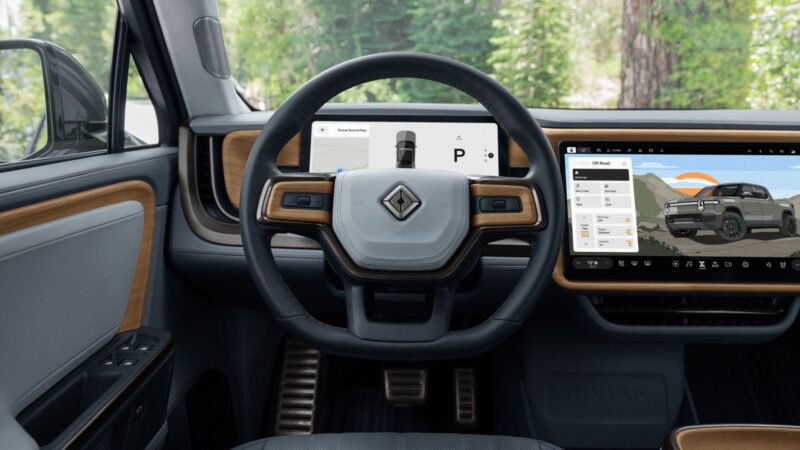
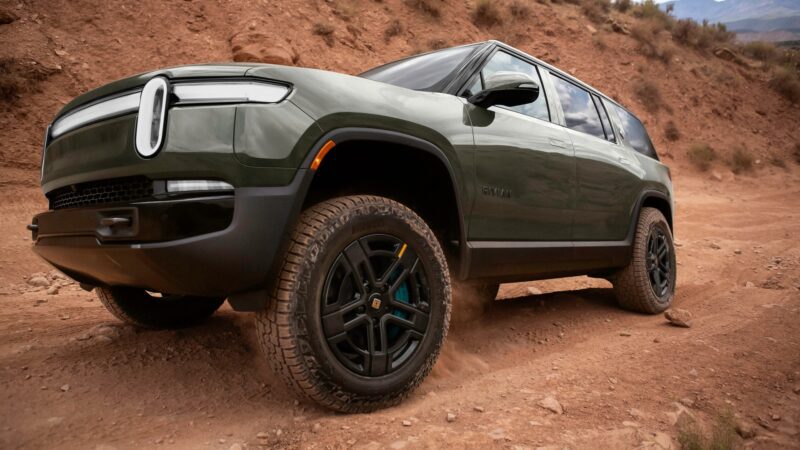
First impressions revealed perhaps a slight positive improvement even before I started digging into menu options, admittedly. The R1S Quad I started the day in weighs around 6,800 pounds, but received new suspension tuning to handle such massive torque gains and improved grip for a new set of Michelin Pilot Sport S 5 summer tires. This helped to reduce some of the suspension clunks that I discovered in previous Rivians, but the steering wheel still displayed odd shuddering and vibrations.
The steering and suspension need to work hard to manage so much weight – not to mention the 7,000-pound R1T Quad – but I did manage to ameliorate some of the woes through RAD Tuner by setting the steering assist to Standard, the ride height to Low, the shock damping to 40%, and the roll stiffness to Soft. Here, combining the plushest ride with a rear-biased torque split of 70:30 and full regenerative braking, seemed to keep the Rivian’s weight in a happy place.
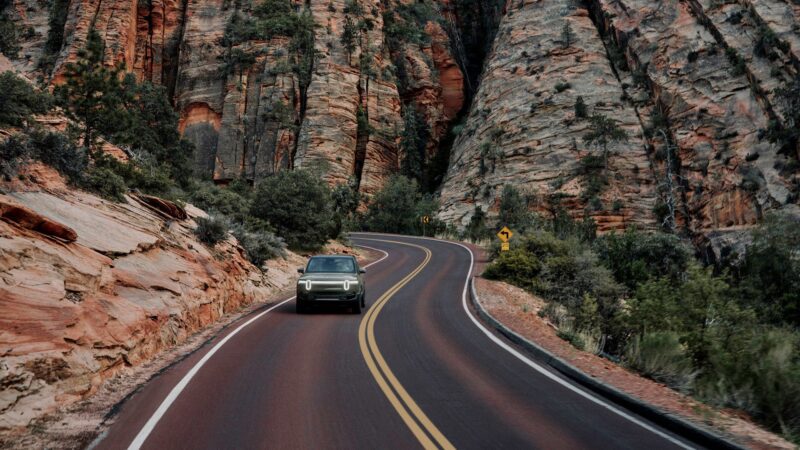
But when I then stiffened everything up into Sport mode and started ripping up the winding road toward Donner Pass, the sheer acceleration and handling also effectively masked much of that mass. Without exaggeration, I managed a 3.15-second sprint to 60 mph using launch control, even while going up a slight incline on the straightest section of road I could find. And that was without prepping the tires at all, just by switching on Launch Control then stepping on the brake pedal, pushing the accelerator to the floor, and stepping off the brake.
Exploring Tech on the Trails

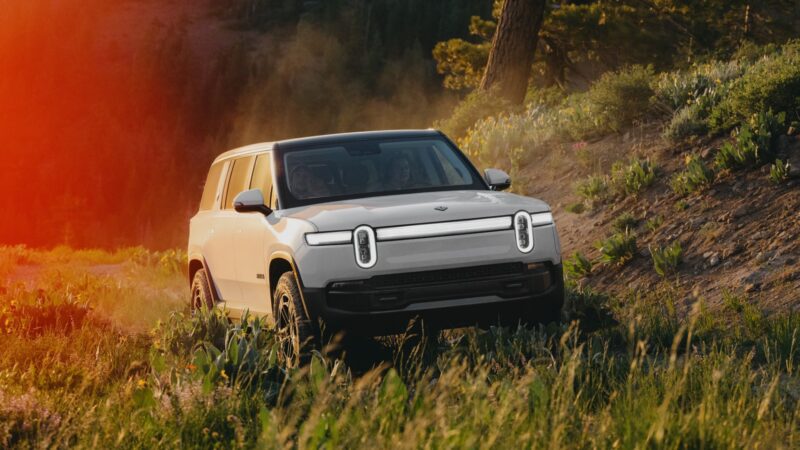
I made sure to push my head back into the headrest to avoid whiplash, since the Quad puts out enough punch to quite literally take my breath away. Some supercars and EVs might manage slightly quicker times – the Rimac Nevera and Lucid Air Sapphire come to mind – but it’s hard to match the unbelievable sensation of something so big accelerating so quickly. And nothing, bar none, in a similar performance class can come anywhere near the off-road capability of a Rivian.
At the top of Donner Pass, I swapped into a new R1S Quad Motor equipped with smaller off-road wheels that mimic a classic Method Rally Series design and come shod in Pirelli all-terrain tires. A group of spotters directed our caravan over some rocks, coaching us along as we climbed little obstacles, powered up steep inclines, and negotiated a few technical cross-axle balancing situations. The Rivians all got the job done, but I spent most of the time simply watching the spotters’ directions, rather than taking advantage of the 11 onboard cameras. I also turned off Hill Hold mode after a few minutes to let me left-foot brake while improving throttle response, since I kept easily spinning the tires with all that unbelievable torque available so quickly.
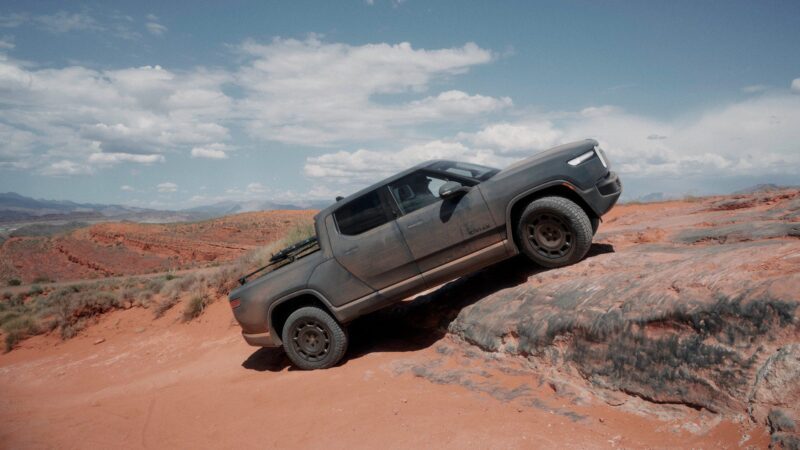
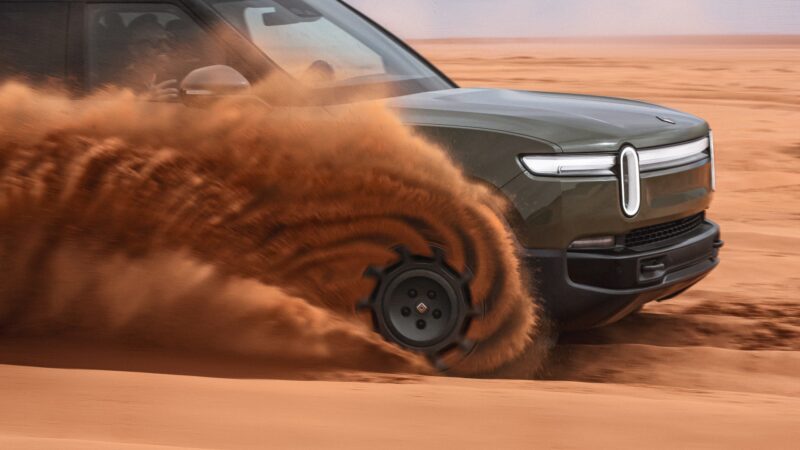
Then, we ventured over to a wide open dirt pad to test Kick Turn, the coolest new addition to the Gen 2 other than RAD Tuner. Kick Turn will only come on the Quad, because the system uses all four motors simultaneously to spin one side’s two wheels forward and the other two in reverse. It’s easy to turn on, with a little graphic of Gear Guard doing a jump kick on the center touchscreen. Then, actually using Kick Turn takes a moment of mental adjustment, since turning no longer requires actually turning the steering wheel. Instead, either at speeds up to 15 mph, holding both buttons on the steering wheel in either direction prompts one side’s motors to spin in reverse.
Think of the Mercedes-Benz G580 with EQ Technology, which features a similar “Tank Turn” function. Rivian’s Kick Turn can do the same thing while stopped, but is much more useful in the real world to either turn the Quad into a legit trail-runner by slinging around tight switchbacks, or a legitimate drift machine by starting a rotation then pushing out with more throttle and a bit of countersteering.
Rivian Gen 2 Quad Motor: Conclusions
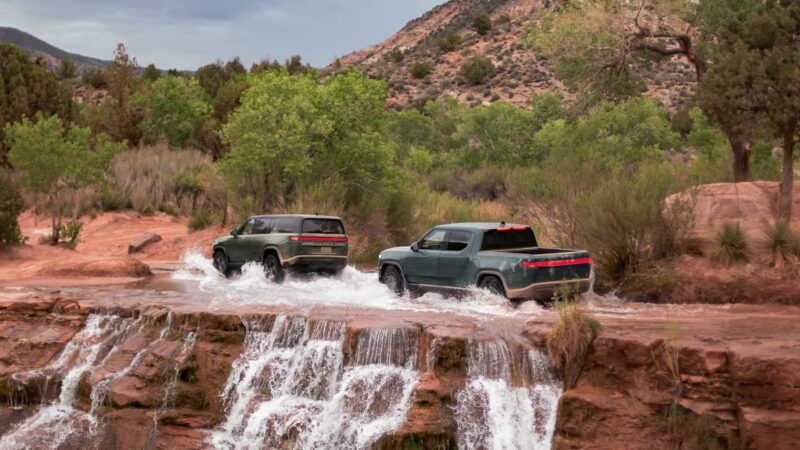
As impressive as the power and tech of the new Quad seemed throughout such variable conditions in Tahoe, Rivian clearly makes tradeoffs to cover as wide a range of potential use cases as possible. In direct competition, for example, the Rivian can’t stack up to the dual-motor Lucid Gravity Grand Touring’s nimble handling nor its far more engaging steering and suspension (by a long shot). Now imagine the Gravity’s inevitable Sapphire version with another motor between the rear wheels. Plus, Lucid’s three-row features more space on the interior than an R1S – but achieves that impressive volume thanks to minivan styling that I struggle to move past no matter how sublime the engineering.
Then there’s the Escalade IQ, which leans more toward the traditional luxury buyer with impressive presence, more space inside, and opulent touches ranging from chrome and leather to the enormous touchscreens and up to 40 interior speakers. The electric Escalade can also manage an absurd 480 miles of range, but weighs well over a ton more and costs half again as much.
The new Gen 2 Rivian Quads start at $115,990 for the R1T and $121,990 for the R1S. Each blurs the lines between a stylish option for city life and enough capability for those weekends out camping with the family. And Rivian also provides a happy alternative outside the traditional automotive manufacturer sphere, with a tech-friendly user experience – that’s critically not a Tesla Model X or Y.
Until the forthcoming R2 and R3 models debut, if you simply must have a Rivian, the Gen 2 Quad’s unbelievable power, and those fun Kick Turn and RAD Tuner features definitely make it the way to go. Plus, the Quad will debut with standard NACS port to charge up at Tesla Superchargers, an absolute gamechanger until the rest of the lineup receives them for model year 2026.
Track Review: Corvette ZR1 Proves 1,000 HP Doesn’t Need A Seven-Figure Price
in Chevrolet, Corvette, Reviews
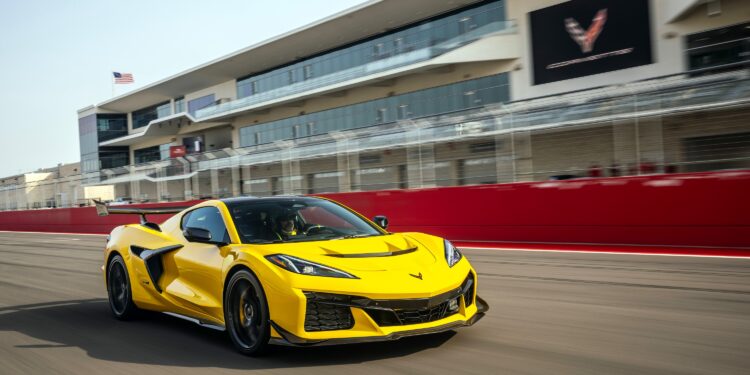
Only one place made sense for Chevrolet to debut the new Corvette ZR1, the most powerful car ever from any major American automaker that’s on sale today and the most powerful internal-combustion car in the world priced under $1 million. Perhaps I shouldn’t have been surprised, then, that Chevy invited me to join select media for a day at Circuit of the Americas, the home of Formula 1’s United States Grand Prix, where every last drop of the new ZR1’s unbelievable 1,064 horsepower might actually come in handy.
At COTA, Chevrolet’s engineering team explained that the ZR1 fit into the plan for an eighth-generation Corvette from the get-go. Sure, switching to a mid-engine layout helped the C8 compete with other supercars by improving balance, traction, and handling. But the wider engine bay also allowed for the sheer physical space to bolt in a 5.5-liter V8 with a massive 76-millimeter turbocharger on each side. By contrast, the previous generation’s front engine bay was simply too narrow, which dictated the use of the more compact supercharged LT5 V8 that produced “only” 755 horsepower.
That former top-spec ’Vette earned a reputation for being an untamable beast, so during the C8’s development process, the original goal was for the ZR1 to hit “just” 850 horsepower. But soon enough, four figures came into sight, and the engineers clearly went power mad. How can a major automaker reliably produce so much from just 5.5 liters of displacement? First of all, the LT7 engine clearly resembles the naturally aspirated Z06’s screaming LT6 with its flat-plane crank, but now features revised air routing to handle more intake and exhaust from the cylinders. Those turbos are also the largest ever fitted to a production vehicle, capable of pushing 24-25 psi of max boost right up as close to the limit of rotational velocity as possible before the internal vanes would simply shear off and detonate the engine.
In testing, Chevy even broke a couple of dynos before eventually reaching the final output of 1,064 horsepower, which allows for a claimed 0-to-60 time of just 2.3 seconds. That figure bordered on the edge of believability, though, due to the ZR1’s rear-wheel-drive layout, until real-world testing proved that the car might be even quicker thanks to the prodigious grip of the massive 345-millimeter-wide rear tires.
The rest of the ZR1’s recipe follows in similar fashion, with more cooling and aero to complement the prodigious power. At COTA, the track setup looked somewhat like the naturally aspirated Z06, but with every dial turned up to 11. So much so that I hit my highest top speed ever, roaring up to 181 miles per hour on the long back straight, early in the day. But the most insane part of that mind-blowing achievement was how calm and capable the ZR1 felt—a testament to the C8’s inherent chassis stability as much as anything else.
Adjusting to a World-Class Track in a World-Beating Supercar
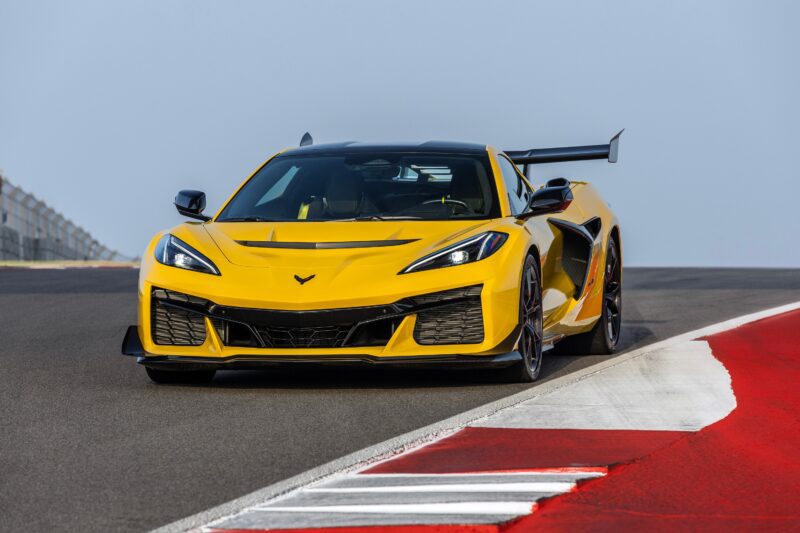
Chevy had started us out in a fleet of base Z51 Stingrays the afternoon before, to help burn off any jitters while adjusting to COTA’s surprisingly tricky twists and turns in a car with 495 horsepower on tap. I had never driven the circuit before, but even just warming up in the Z51, I crested well over 140 miles an hour, which helped me build up a bit more confidence ahead of the next day in the ZR1.
As with the Z06, which now slots in between the Z51 and ZR1, Chevy offers two main configurations: a softer, more road-biased chassis (option code FE8) equipped with Michelin Pilot Sport 4 S tires or the more hardcore FEJ package that adds stiffer springs, revised MagneRide shock damper tuning, and Cup 2 R tires.
Then there is the choice of aero, which starts with a low-drag standard configuration that allows for the ZR1’s top speed of 233 miles per hour—another real-world stat that Chevy hit last year at Papenburg, Germany, with GM President Mark Reuss behind the wheel (also setting a record for the highest top speed of any car in the world under $1 million). For shaving lap times, rather than setting top speed records, the optional ZTK aero package adds a larger Gurney flap ahead of the front heat extractor, dive planes, and an enormous wing to produce total downforce of 1,200 pounds.
Adding the ZTK package cuts into that potential top speed, but it was a worthy tradeoff at COTA, where I relied more on downforce at threshold braking while trying to haul down from 181 miles an hour before the next corner. Plus, a bit more grip while ripping through tight turns and wide sweepers alike only emphasized the C8’s mid-engine balance. By just a few laps into my first stint in the “base” FE8 ZR1, I already started putting enough pressure on the PS4S tires to sense some slip-and-slide fun. Then we stepped up to the more hardcore FEJ and ZTK cars.
Hitting Full Throttle with the Hardcore FEJ and ZTK Packages
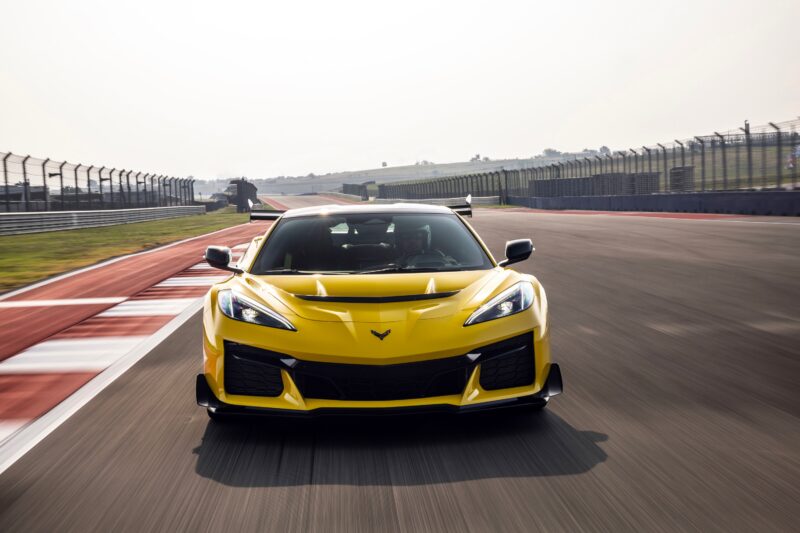
Immediately, I noticed renewed feedback from the front end, as the grippier Cup 2 R tires absolutely glued to the tarmac. But revised programming for the electronically assisted steering also shone through, too. Meanwhile, the ZR1 could now put down all that power much more effectively, stomping out of corners with far more punch and hitting higher speeds through every portion of the track than I ever expected from something that weighs over 3,500 pounds. The sheer physics of going so fast seemed to melt my brain, and I legitimately struggled to find the speed I knew the ZR1 could handle. Almost lucky, then, that for full-throttle sessions, the fuel tank starts to run dry after just eight to ten laps.
After a quick stop to top up on 91 octane, I roared back out onto the track determined to push harder, and harder, and harder. But the ZR1 just took everything I threw at it without any concern, as shown by the oil temp gauge rarely climbing above 220-degree Fahrenheit. All this on a hot and humid Texas afternoon, when engineers estimated the engine probably detuned itself by around 5-10% to prevent heat soak in the turbos.
Not bad, to say the least. Yet even as much as I reveled in the engineering prowess of the more hardcore FEJ and ZTK packages at COTA, I suspect the ride quality likely ends up far too stiff for enjoyable driving on public roads—even with the MagneRide dampers set to their softest mode. I’ll need more time alone with the ZR1 to be certain, though somehow I doubt that GM will allow journalists much in the way of unsupervised fun with such a boisterous car.
The only way that Chevy – or any automaker, for that matter – can responsibly sell a rear-wheel-drive supercar this powerful comes down to modern traction control programming. At COTA, we stayed in Sport mode, and I noticed frequent power cuts when pushing out of corners or rolling over curbs under acceleration. Eventually, ZR1 owners will no doubt figure out how to turn off the electronic nannies entirely and discover how quickly this beast can wind up and spin out, which explains why so many cars, ever since the Bugatti Veyron eclipsed that four-figure horsepower rating, tend to rely on all-wheel-drive.
Not so for the Corvette ZR1, or at least not yet until the ZR1X variant arrives later this year with an electric motor powering the front wheels to produce a combined output of 1,250 horsepower. The ZR1X will share that same widebody design with the Z06, but with the ZR1’s sacrificial front trunk, similarly enhancing the cooling capability and downforce.
The New Corvette ZR1: Conclusions
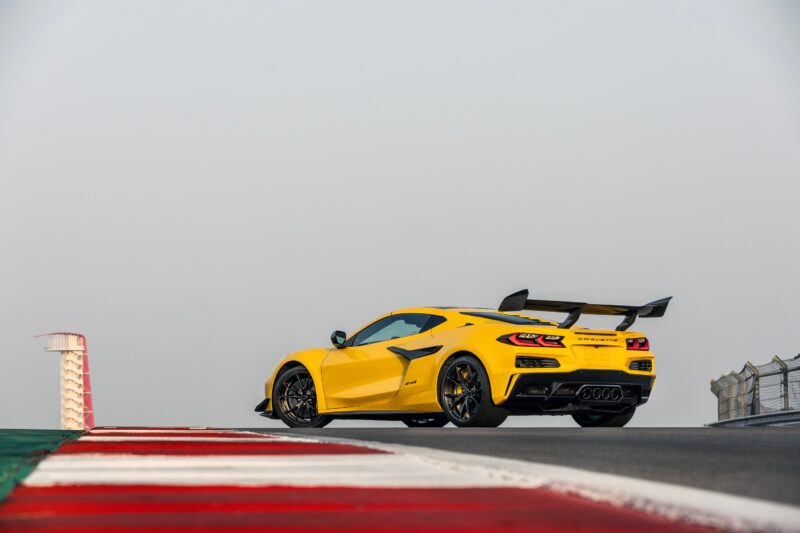
And even after a romping day at COTA, I still must admit how much the C8’s design emerges as the least appealing aspect of the ZR1. The mid-engine supercar shape looks a bit more sleek with the low aero package, but the aggressive ZTK package’s enormous wing almost entirely blocks any rear visibility. And the interior still unfortunately features a claustrophobic center console and entirely unintuitive controls. Thankfully, Chevy has already revealed an updated interior layout for model year 2026, with new screens and switchgear, plus a handle for passengers to grab onto during hard charging moments.
I’d advocate for waiting to buy a ZR1 until 2026 model years hit dealer lots, just for that reason, but the decision to sell a limited number officially as model year 2025 with the old interior may add to the rarity factor for early orders. For now, tacking on options including the electrically controlled hardtop convertible or either the FEJ or ZTK packages can easily bump the MSRP to right around $200,000 from a base price of $174,995.
But that’s still a fraction of any comparable powerful supercars, most of which rely on hybrid power and all-wheel drive to achieve such unbelievable outputs. For the sake of comparison, the 1,001-horsepower Lamborghini Revuelto starts at just over $600,000 but uses three electric motors plus a big V12. The Ferrari F80 can beat the ZR1 with 1,184 horsepower, but costs at least $3.1 million – and is also a hybrid. And the McLaren W1 will produce 1,258 horsepower from another hybrid powertrain, but starts at $2.1 million.
All those hybrid supercars occupy much more rarefied air than the ZR1, which will be available at Chevy dealers here in the United States. In many ways, the most appropriate comparison for the ZR1 will be the impressive McLaren 750S – just with the track prowess of a Porsche GT3 RS and about 400 more horsepower thrown in for good measure. What an unbelievable achievement by Chevrolet, to produce something so undeniably excessive yet surprisingly approachable and attainable, all things considered.
Though the exoticism factor might fall far short of the industry’s European supercar standouts, for now, the Corvette ZR1 represents the most affordable way in the world to purchase significantly more than 1,000 screaming internal-combustion horsepower with a warranty.



